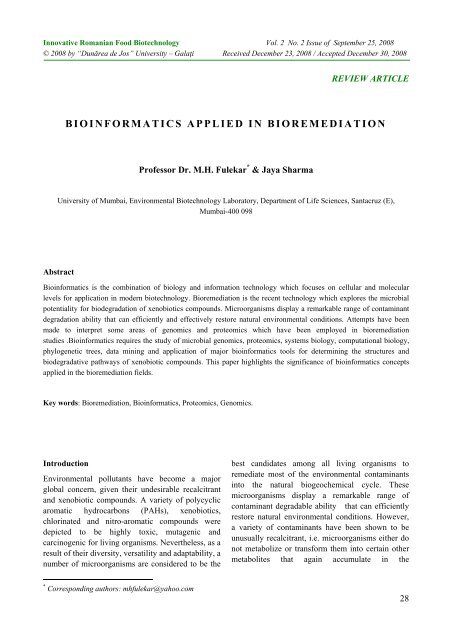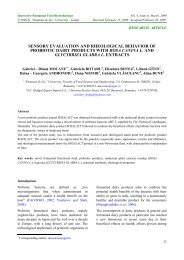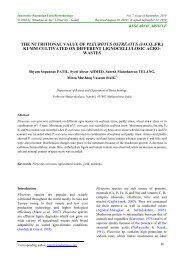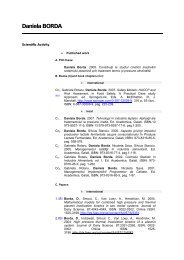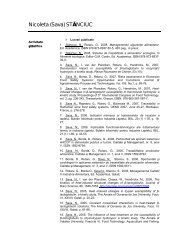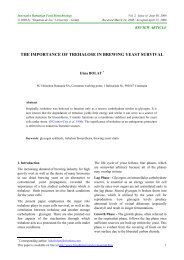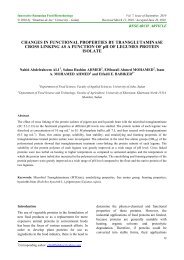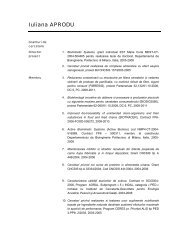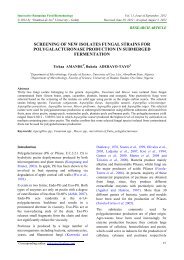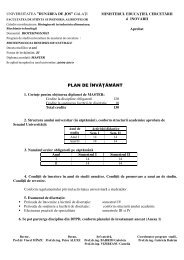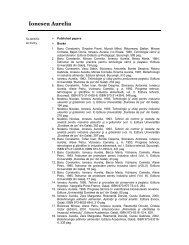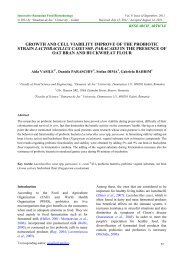BIOINFORMATICS APPLIED IN BIOREMEDIATION - Bioaliment
BIOINFORMATICS APPLIED IN BIOREMEDIATION - Bioaliment
BIOINFORMATICS APPLIED IN BIOREMEDIATION - Bioaliment
Create successful ePaper yourself
Turn your PDF publications into a flip-book with our unique Google optimized e-Paper software.
Innovative Romanian Food Biotechnology Vol. 2 No. 2 Issue of September 25, 2008© 2008 by “Dunărea de Jos” University – Galaţi Received December 23, 2008 / Accepted December 30, 2008REVIEW ARTICLE<strong>BIO<strong>IN</strong>FORMATICS</strong> <strong>APPLIED</strong> <strong>IN</strong> <strong>BIOREMEDIATION</strong>Professor Dr. M.H. Fulekar * & Jaya SharmaUniversity of Mumbai, Environmental Biotechnology Laboratory, Department of Life Sciences, Santacruz (E),Mumbai-400 098AbstractBioinformatics is the combination of biology and information technology which focuses on cellular and molecularlevels for application in modern biotechnology. Bioremediation is the recent technology which explores the microbialpotentiality for biodegradation of xenobiotics compounds. Microorganisms display a remarkable range of contaminantdegradation ability that can efficiently and effectively restore natural environmental conditions. Attempts have beenmade to interpret some areas of genomics and proteomics which have been employed in bioremediationstudies .Bioinformatics requires the study of microbial genomics, proteomics, systems biology, computational biology,phylogenetic trees, data mining and application of major bioinformatics tools for determining the structures andbiodegradative pathways of xenobiotic compounds. This paper highlights the significance of bioinformatics conceptsapplied in the bioremediation fields.Key words: Bioremediation, Bioinformatics, Proteomics, Genomics.IntroductionEnvironmental pollutants have become a majorglobal concern, given their undesirable recalcitrantand xenobiotic compounds. A variety of polycyclicaromatic hydrocarbons (PAHs), xenobiotics,chlorinated and nitro-aromatic compounds weredepicted to be highly toxic, mutagenic andcarcinogenic for living organisms. Nevertheless, as aresult of their diversity, versatility and adaptability, anumber of microorganisms are considered to be thebest candidates among all living organisms toremediate most of the environmental contaminantsinto the natural biogeochemical cycle. Thesemicroorganisms display a remarkable range ofcontaminant degradable ability that can efficientlyrestore natural environmental conditions. However,a variety of contaminants have been shown to beunusually recalcitrant, i.e. microorganisms either donot metabolize or transform them into certain othermetabolites that again accumulate in the* Corresponding authors: mhfulekar@yahoo.com28
Bioinformatics applied in bioremediation Innovative Romanian Food Biotechnology (2008) 2, 28-36environment. Therefore, it may be more productiveto explore new catabolic pathways that might leadtowards complete mineralization of these pollutants.One of the reasons, our knowledge of microbialdegradation pathways is so incomplete is theimmense complexity of microbial physiology thatallows response and adaptability to various internaland external stimuli (Fulekar, 2007).Bioremediation has a potential to restorecontaminated environments inexpensively yeteffectively, but a lack of information about thefactors controlling the growth and metabolism ofmicroorganisms in polluted environments oftenlimits its implementation. Researchers now have theability to cultivate microorganisms that areimportant in bioremediation and can evaluate theirphysiology using a combination of genome-enabledexperimental and modeling techniques. In addition,new environmental genomic and proteomictechniques offer the possibility for similar studies(Nair, 2007). Bioinformatics is based on proteomicsand genomics offer remarkable promise as tools toaddress longstanding questions regarding themolecular mechanisms involved in the control ofmineralization pathways. During mineralization,transcript structures and their expression have beenstudied using high-throughput transcriptomicstechniques with microarrays. Generally however,transcripts have no ability to operate anyphysiological response; rather, they must betranslated into proteins with significant functionalimpact. These proteins can be identified byproteomic techniques using powerful twodimensionalpolyacrylamide gel electrophoresis (2-DE). Towards the establishment of functionalproteomics, the current advances in massspectrometry (MS) and protein microarrays play acentral role in the proteomics approach. Exploringthe differential expression of a wide variety ofproteins and screening the entire genome forproteins that interact with particular mineralizationregulatory factors would help us to gain insights intobioremediation (Fulekar, 2008).Overview of BioremediationBioremediation is defined as a process by whichmicroorganisms are stimulated to rapidly degradehazardous organic pollutants to environmentally safelevels in soils, sediments, substances, materials andground water. Recently, biological remediationprocess has also been devised to either precipitateeffectively or immobilize inorganic pollutants suchas heavy metals. Stimulation of microorganisms isachieved by the addition of growth substances suchas nutrients, terminal electron acceptors/donors orsome combination thereby resulting is an increase inorganic pollutant degradation and biotransformation.The energy and carbon are obtained through themetabolism of organic compounds by the microbesinvolved in bioremediation processes (Fulekar, 2005).Biodegradation is nature's way of recycling wastes,or breaking down organic matter into nutrients thatcan be used by other organisms. The degradation iscarried out by the microorganisms: bacteria, fungi,insects, worms etc. by taking nutrients such as C,N,Pfrom the contaminant which on long termacclimatization convert the toxic compound intoenvironment friendly compound. By harnessingthese natural forces of biodegradation, people canreduce wastes and clean up some types ofenvironmental contaminants. Through composting,we accelerate natural biodegradation and convertorganic wastes to a valuable resource. Wastewatertreatment also accelerates natural forces ofbiodegradation, breaking down organic matter sothat it will not cause pollution problems when thewater is released into the environment. Throughbioremediation, microorganisms are used to clean upoil spills and other types of organic pollution.Therefore, in situ bioremediation provides atechnique for cleaning up pollution by enhancing thesame biodegradation processes that occur in nature(safer, less expensive and treatment in place).Bioremediation of a contaminated site typicallyworks in one of two ways:• To enhance the growth of whatever pollutioneatingmicrobes might already be living at thecontaminated site• Specialized microbes are added to degrade thecontaminants (less common).The fields of Biodegradation and Bioremediationoffer many interesting and unexplored possibilitiesfrom the bioinformatics point of view. They need tointegrate a huge amount of data from different29
Innovative Romanian Food Biotechnology Vol. 2 No. 2 Issue of September 25, 2008© 2008 by “Dunărea de Jos” University – Galaţi Received December 23, 2008 / Accepted December 30, 2008sources: chemical structure and reactivity of theorganic compounds; sequence, structure andfunction of proteins (enzymes); comparativegenomics; environmental biology etc.Bioinformatics provides data base for microarrays,gene identification and microbial degradationpathways of compounds (Ellis et al. 2001).BioinformaticsBioinformatics is the combination of biology andinformation technology. It is the branch of sciencethat deals with the computer based analysis of largebiological data sets. Bioinformatics incorporates thedevelopment to store and search data and ofstatistical tools and algorithms to analyze anddetermine relationships between biological data sets,such as macromolecular sequences, structures,expression profiles and biochemical pathways.Bioinformatics is the focus on cellular and molecularlevels of biology. Biology and computers arebecoming close cousins which are mutuallyrespecting, helping and influencing each other andsynergistically merging more than ever (Fulekar,2008). The huge data from biology mainly in theform of DNA, RNA and protein sequences is puttingheavy demand on computers and computationalscientists. Bioinformatics has taken on a newglittering by entering in the field of Bioremediation.Bioinformatics is the application of computersciences and related technology to the industries forusing the huge available database for computationalbiology. Computational biologists are those who arespecialized in using of computational tools andcomputer systems to solve the problems of biologyin the area of bioinformatics (Westhead, 2003). Themajor branches of bioinformatics are genomics,proteomics, biological databases, data mining,molecular phylogenetics, microarray informatics andsystems biology, which are playing a vital role inunderstanding bioinformatics and its applications.The roles of bioinformatics related tools aredescribed for bioremediation of hazardous wastes todevelop environmental clean up technology.1. ProteomicsThe terms ‘proteomics’ and ‘proteome’ wereintroduced in 1995 , which is a key post genomicfeature that emerged from the growth of large andcomplex genome sequencing datasets. Proteomicanalysis is particularly vital because the observedphenotype is a direct result of the action of theproteins rather than the genome sequence.Traditionally, this technology is based on highlyefficient methods of separation using twodimensionalpolyacrylamide gel electrophoresis (2-DE) and modern tools of bioinformatics inconjunction with mass spectrometry (MS). However,2-DE has been considered to be a limited approachfor very basic and hydrophobic membrane proteinsin compartmental proteomics. In bioremediation, theproteome of the membrane proteins is of highinterest, specifically in Polycyclic AromaticHydrocarbon biodegradation. The improvements in2-DE for use in compartmental proteomics havebeen made by introducing an alternative approachfor multidimensional protein identificationtechnology (MudPIT) (Santos, 2004).1.1. Bioremediation using ProteomicsThe cellular expression of proteins in an organismvaries with environmental conditions. The changesin physiological response may occur due to theorganism’s adaptive responses to different externalstimuli, such as the presence of toxic chemicals inthe environment. The advent of proteomics hasallowed an extensive examination of global changesin the composition or abundance of proteins, as wellas identification of key proteins involved in theresponse of microorganisms in a given physiologicalstate. A number of reports have described sets ofproteins that are up- or down-regulated in responseto the presence of specific pollutants. PAHs,ubiquitous environmental pollutants are extremelyimportant to remove from the environment. In situand ex situ bioremediation of PAHs has beenpartially achieved using natural and geneticallyengineered microorganisms. Using a proteomicsapproach, the physiological changes in an organismduring bioremediation provide further insight intobioremediation-related genes and their regulation.An 81-kDa protein similar to catalase–peroxidase30
Bioinformatics applied in bioremediation Innovative Romanian Food Biotechnology (2008) 2, 28-36that expressed in response to pyrene exposure wasrecovered using 2-DE from Mycobacterium sp.strain PYR-1. Later, six major proteins weresignificantly induced and overexpressed on 2-DEwhen Mycobacterium sp. strain PYR-1 was exposedto phenantherene, dibenzothiophene and pyrene.Several pyrene-specific polypeptides were identifiedby N-terminal and internal peptide sequencing asputative enzymes. Furthermore, the induction of tworing-hydroxylating dioxygenases, i.e. Pdo1 and Pdo2,in response to pyrene was proposed during pyrenecatabolism by Mycobacterium sp. strain 6PY1. Acomposite profile for 20 PAH-induced proteins waspresented when organism Mycobacteriumvanbaabenii PYR-1was grown in the presence ofhigh-molecular-weight PAHs. Progress has beenmade towards identification of unknown genes andproteins during anaerobic biodegradation of tolueneand ethylbenzene. A global expression analysis(DNA microarray and proteomics) was performedusing denitrifying bacterium strain EBN1 adapted toanaerobic growth with benzoate, toluene,ethylbenzene and a mixture of toluene andethylbenzene. Besides various differentiallyexpressed genes and related proteins, the expressionof two toluene-related operons (bss and bbs) wasspecifically induced in toluene-adapted cells. Inagreement with the sequential regulation of theethylbenzene pathway, Ebd proteins were reportedto be formed in ethylbenzene-adapted cells but notin acetophenon-adapted cells, while Apc proteinswere found to be formed under both conditions. Therecent combined approaches of transcriptomics andproteomics have revealed new pathways for aerobicand anaerobic biodegradation of toxic wastes thatwill certainly pave the way for further identificationof new signature proteins (Chen, 2009).2. GenomicsGenomic is a powerful computer technology used tounderstand the structure and function of all genes inan organism based on knowing the organism’s entireDNA sequence. The field includes intensive effortsto determine the entire DNA sequence of organismsand fine-scale genetic mapping efforts. The fieldalso includes studies of intragenomic phenomenasuch as heterosis, epistasis, pleiotropy and otherinteractions between loci and alleles within thegenome. In contrast, the investigation of singlegenes, their functions and roles, something verycommon in today's medical and biological research,and a primary focus of molecular biology, does notfall into the definition of genomics, unless the aim ofthis genetic, pathway, and functional informationanalysis is to elucidate its effect on, place in, andresponse to the entire genome's networks.2.1. Bioremediation using GenomicsNon-molecular techniques: at present, most appliedmicrobiological investigations of bioremediationprocesses make use of the ‘treatability study’ inwhich samples of the contaminated environment areincubated in the laboratory and the rates ofcontaminant degradation or immobilization aredocumented. Such studies provide an estimate of thepotential metabolic activity of the microbialcommunity, but give little insight into themicroorganisms that are responsible forbioremediation, or why particular amendments thatcan be evaluated for engineered bioremediationapplications do or do not stimulate activity.When bioremediation processes are researched inmore detail, attempts are generally made to isolatethe organisms responsible. The isolation andcharacterization of pure cultures has been and willcontinue to be crucial for the development andinterpretation of molecular analysis. The recovery ofisolates that are representative of themicroorganisms responsible for bioremediationprocesses can be invaluable because, as outlinedbelow, studying these isolates provides theopportunity to investigate not only theirbiodegradation reactions , but also other aspects oftheir physiology that are likely to control theirgrowth and activity in contaminated environments.However, before the application of moleculartechniques to bioremediation, it was uncertainwhether the isolated organisms were important inbioremediation in situ, or whether they were weedsthat grew rapidly in the laboratory but were not theprimary organisms responsible for the reaction ofinterest in the environment (Fulekar, 2005).Evolutionary approaches are extremely useful foroptimization of an entire biodegradation pathwaycomparing to step by- step modifications offered by31
Innovative Romanian Food Biotechnology Vol. 2 No. 2 Issue of September 25, 2008© 2008 by “Dunărea de Jos” University – Galaţi Received December 23, 2008 / Accepted December 30, 2008rational design. This was recently demonstrated bythe modification of an arsenic resistance operonusing DNA shuffling. Cells expressing the optimizedoperon grew in up to 0.5 M arsenate, a 40-foldincrease in resistance. Moreover, a 12-fold increasein the activity of one of the gene products (arsC) wasobserved in the absence of any physical modificationto the gene itself. The authors speculate thatmodifications to other genes in the operon effect thefunction of the arsC gene product. Such unexpectedbut exciting results are more likely to be realizedusing irrational approaches. This strategy isparticularly attractive since the ultimate goal ofmany remediation approaches is for completemineralization of the pollutants, and the concurrentoptimization of an entire pathway will allow theefficient search for the correct coordination betweena complex set of biodegradation reactions. Along thesame line, recent advances in genome shufflingbetween species, which allow the exchange andrecombination of diverse pathways into a singlespecies, will further accelerate the discovery ofnovel microbes that are useful for the remediation ofeven a complex mixture of pollutants (Wilfred, 2005).3. Genomics and Proteomics in BioremediationThe growing demands of genomics and proteomicsfor the analysis of gene and protein function from aglobal bioremediation perspective are enhancing theneed for microarray-based assays enormously. In thepast, protein microarray technology has beensuccessfully implicated for the identification,quantification and functional analysis of protein inbasic and applied proteome research. Other than theDNA chip, a large variety of protein-microarraybased approaches have already been verified thatthis technology is capable of filling the gap betweentranscriptomics and proteomics (Singh et al. 2006).The availability of bacterial genomes relevant tobiodegradation in recent years has allowed thefeasibility to study the complex interactions betweencellular reactions from a genomic and proteomiclevel. A quantitative understanding of how cellsfunction requires every gene and protein to beplaced in their dynamic context, which entails theintegrated consideration of many interactingcomponents. From this perspective, a systembiology approach is necessary to predict thefunctioning of an organism in a complexenvironment and to describe the outcome of thethousands of individual reactions that aresimultaneously taking place in a microbial cell. Sofar, such prokaryotic models have been limitedprimarily to E. coli and a few pathogens. However,similar modeling approaches should be able topredict contaminant bioremediation bymicroorganisms that are known to predominate inpolluted environments. Recently, de Lorenzo et al.(2003) presented a pioneering study on thecharacteristics of the “global biodegradationnetwork”, in which they considered the global poolof known chemical reactions implicated inbiodegradation regardless of their microbial hosts.The characteristics of this network support anevolutionary scenario in which the reactions evolvedfrom the central metabolism toward more diversifiedreactions, allowing us to understand the evolution ofnew pathways for the degradation of xenobiotics andprovide the basis for predicting the abilities ofchemicals to undergo biological degradation, and forquantifying the evolutionary rate for theirelimination in the future. This type of analysis, whencoupled with the predictive approach for microbialcatabolism using the University of MinnesotaBiocatalysis/Biodegradation Database (UM-BBD) asa knowledge base and various sets of heuristic rules,33 will lead to untapped and improved strategies forbioremediation. This represents an excellentopportunity for chemical engineers who are alreadyinvolved with system biology, and will undoubtedlyevolve into an important research direction withinthe next 5 years (Wilfred, 2005).4. Systems BiologyThe rise of genomic technologies and systemsbiology provide fresh approaches to currentlyuntactable biological processes that are at the root ofserious environmental problems. One formidablechallenge in this respect is the biological fate of thenearly 8 operons, etc. implicated in this process. Thebiodegradation database of the University ofMinnesota documented new chemical compounds(~40 000 predominant) which are common inmodern Organic and Industrial Chemistry. A large32
Bioinformatics applied in bioremediation Innovative Romanian Food Biotechnology (2008) 2, 28-36number of microbial strains are able to grow onenvironmental pollutants (about 800 today).Bioremediation was studied from a molecularbiology point of view, characterizing the chemicalreactions, genes; University of Minnesota has madea pioneering effort in putting together nearly everyaspect of our current knowledge on biodegradationpathways and in developing systems for dealing withthat data e.g. to learn rules for predictingbiodegradative features. Yet, most informationavailable in the literature of microbialbiodegradation of xenobiotics and recalcitrantchemicals deals with duos consisting of onepollutant versus one strain and thus, lacks essentialaspects of the natural scenarios, like the interchangeof genes between bacteria or their metaboliccooperation. This study of genomes and‘functionomes’ from a community point of view (incontrast to organism point of view) is leading, forexample, to the sequencing of ‘genomes’ ofcommunities and ecosystems, instead of singleorganisms. These circumstances expose the need toqualify and to represent the information available inbiodegradation databases in a fashion in which theentire known biodegradative potential of themicrobial world can be crossed with the wholecollection of compounds known to be partially ortotally degraded through (mostly) bacterial action(Kitano, 2002).5. Computational biologyA computational biology is a sub discipline withinbioinformatics concerned with computation-basedresearch devoted to understanding basic biologicalprocesses. It encompasses the fields of:• Bioinformatics, which applies algorithms andstatistical techniques to the interpretation,classification and understanding of biologicaldatasets. Datasets typically consist of largenumbers of DNA, RNA, or protein sequences.Sequence alignment is used to assemble thedatasets for analysis. Comparisons ofhomologous sequences, gene finding, andprediction of gene expression are the mostcommon techniques used on assembled datasets;however, analysis of such datasets have manyapplications throughout all fields of biology.• Computational biomodeling, a field withinbiocybernetics concerned with buildingcomputational models of biological systems.• Computational genomics, a field withingenomics which studies the genomes of cellsand organisms. High-throughput genomesequencing produces lots of data, which requiresextensive post-processing (genome assembly)and uses DNA microarray technologies toperform statistical analyses on the genesexpressed in individual cell types. This can helpfind genes of interests for certain diseases orconditions. This field also studies themathematical foundations of sequencing.• Molecular modeling, which consists ofmodelling the behaviour of molecules ofbiological importance.• Systems biology, which uses systems theory tomodel large-scale biological interactionnetworks (also known as the interactome).• Protein structure prediction and structuralgenomics, which attempt to systematicallyproduce accurate structural models for threedimensionalprotein structures that have notbeen determined experimentally.• Computational biochemistry and biophysics,which make extensive use of structural modelingand simulation methods such as moleculardynamics and Monte Carlo method-inspiredBoltzmann sampling methods in an attempt toelucidate the kinetics and thermodynamics ofprotein functions.(Nair, 2007)6. Phylogenetic treesA phylogenetic tree or evolutionary tree is a treeshowing the evolutionary relationships amongvarious biological species or other entities that arebelieved to have a common ancestor. In aphylogenetic tree, each node with descendantsrepresents the most recent common ancestor of thedescendants, and the edge lengths in some treescorrespond to time estimates. Each node is called ataxonomic unit. Internal nodes are generally calledhypothetical taxonomic units (HTUs) as they cannotbe directly observed.33
Innovative Romanian Food Biotechnology Vol. 2 No. 2 Issue of September 25, 2008© 2008 by “Dunărea de Jos” University – Galaţi Received December 23, 2008 / Accepted December 30, 2008TypesA rooted phylogenetic tree is a directed tree with anunique node corresponding to the (usually imputed)most recent common ancestor of all the entities atthe leaves of the tree. The most common method forrooting trees is the uses of an uncontroversialoutgroup — close enough to allow inference fromsequence or trait data, but far enough to be a clearoutgroup.Unrooted trees illustrate the relatedness of the leafnodes without making assumptions about commonancestry. While unrooted trees can always begenerated from rooted ones by simply omitting theroot, a root cannot be inferred from an unrooted treewithout some means of identifying ancestry; this isnormally done by including an outgroup in the inputdata or introducing additional assumptions about therelative rates of evolution on each branch, such as anapplication of the molecular clock hypothesis.A dendogram is a broad term for the diagrammaticrepresentation of a phylogenetic tree.A cladogram is a tree formed using cladisticmethods. This type of tree only represents abranching pattern, i.e., its branch lengths do notrepresent time.A phylogram is a phylogenetic tree that explicitlyrepresents number of character changes through itsbranch lengths.An ultrametric tree or chronogram is a phylogenetictree that explicitly represents evolutionary timethrough its branch lengths.7. Data Mining:Data mining (sometimes called data or knowledgediscovery) is the process of analyzing data fromdifferent perspectives and summarizing it into usefulinformation that can be used to increase revenue,cuts costs, or both. Data mining software is one of anumber of analytical tools for analyzing data. Itallows users to analyze data from many differentdimensions or angles, categorize it, and summarizethe relationships identified. Technically, data miningis the process of finding correlations or patternsamong dozens of fields in large relational databases(Cipolla et al. 1995).• Non-traditional Feature Selection When the number of attributes >> number ofsamples? Highly imbalanced• Explainable and Accurate Data Mining Methods• NN, SVM-> Rules?• Transfer Learning Can knowledge learned from one set of sampleshelp data mining on another sample?• Exploiting the network structure Individual i.i.d type of classification vssocial networks?• Current methods, such as SVMs, discriminantanalysis, neural networks, are ‘black box’models.• The learned knowledge is hard to understand bybiologists.• Some potential solutions Logic based method, e.g., decision treesand variants may be better in giving the ‘IF-THEN’ like rules that explicitly define theepigenetic logics in cancer and stem celldevelopment.DNA methylation rules can be learned by using SVMbased recursive feature elimination and fuzzy logics.Major categories of Bioinformatics ToolsThere are both standard and customized products tomeet the requirements of particular projects. Thereare data-mining software that retrieves data fromgenomic sequence databases and also visualizationtools to analyze and retrieve information fromproteomic databases. These can be classified ashomology and similarity tools, protein functionalanalysis tools, sequence analysis tools andmiscellaneous tools.Here is a brief description of a few of these.Everyday bioinformatics is done with sequencesearch programs like BLAST, sequence analysis34
Bioinformatics applied in bioremediation Innovative Romanian Food Biotechnology (2008) 2, 28-36programs, like the EMBOSS and Staden packages,structure prediction programs like THREADER orPHD or molecular imaging/modelling programs likeRasMol and WHATIF.Homology and Similarity ToolsHomologous sequences are sequences that arerelated by divergence from a common ancestor.Thus the degree of similarity between two sequencescan be measured while their homology is a case ofbeing either true of false. This set of tools can beused to identify similarities between novel querysequences of unknown structure and function anddatabase sequences whose structure and functionhave been elucidated.Protein Function AnalysisThis group of programs allows one to compare acertain protein sequence to the secondary (or derived)protein databases that contain information on motifs,signatures and protein domains. Highly significanthits against these different pattern databases allowone to approximate the biochemical function of thequery protein.Structural AnalysisThis set of tools allows one to compare structureswith the known structure databases. The function ofa protein is more directly a consequence of itsstructure rather than its sequence with structuralhomologs tending to share functions. Thedetermination of a protein's 2D/3D structure iscrucial in the study of its function.Sequence AnalysisThis set of tools allows one to carry out further,more detailed analysis on the query sequenceincluding evolutionary analysis, identification ofmutations, hydropathy regions, CpG islands andcompositional biases. The identification of these andother biological properties are all clues that aid thesearch to elucidate the specific function of thesequence.Bioinformatics in Bioremediation-MetaRouterMetaRouter is a system for maintainingheterogeneous information related to Biodegradationin a framework that allows its administration andmining (application of methods for extracting newdata). It is an application intended for laboratoriesworking in this area which need to maintain publicand private data, linked internally and with externaldatabases, and to extract new information from it.The system has an open and modular architectureadaptable to different customers. This multyplatformprogram, implemented in Postgre SQL(standard language for relational databases) andusing SRS as an indexing system (used to connectand query Molecular Biology databases), worksusing a client/server architecture that allows theprogram to run on the user station or on thecompany server, so it can be accessed from anyplace in a secure way just by having a web browser.The University of Minnesota Biocatalysts/BiodegradationDatabase (http://www.labmed.umn.edu/umbbd)begins its fifth year having met its initial goals. Itcontains approximately 100 pathways for microbialcatabolic metabolism of primarily xenobioticorganic compounds, including information onapproximately 650 reactions, 600 compounds and400 enzymes, and containing approximately 250microorganism entries. It includes information onmost known microbial catabolic reaction types andthe organic functional groups they transform.Having reached its first goals, it is ready to movebeyond them. It is poised to grow in many differentways, including mirror sites; fold prediction for itssequenced enzymes; closer ties to genome andmicrobial strain databases; and the prediction ofbiodegradation pathways for compounds it does notcontain ( Ellis et al. 2000).ConclusionBioinformatics technology has been developed toidentify and analyze various components of cellssuch as gene and protein functions, interactions,metabolic and regulatory pathways. Bioinformaticsanalysis will facilitate and quicken the analysis of35
Innovative Romanian Food Biotechnology Vol. 2 No. 2 Issue of September 25, 2008© 2008 by “Dunărea de Jos” University – Galaţi Received December 23, 2008 / Accepted December 30, 2008cellular process to understand the cellularmechanism to treat and control microbial cells asfactories. The next decade will belong tounderstanding molecular mechanism and cellularmanipulation using the integration of bioinformatics.Bioinformatics has wide application inbioremediation for the structure determination andpathways of biodegradation of xenobiotics.References1. Chen X., ShaoPing H., ChaoFeng S., ChangMing D.,JiYan S., Chen Y. (2009). Interaction ofPseudomonas putida CZ1 with clays and ability ofthe composite to immobilize copper and zinc fromsolution. Bioresource Technology., 100.330–337.2. Cipolla and Emil T. (1995).Data Mining: Techniques to Gain Insight into YourData Enterprise Systems Journal .64.18-24.3. Ellis L.B., Hershberger C.D., Bryan M.B., WackettL.P.(2001). The University of MinnesotaBiocatalysis/Biodegradationdatabase:microorganisms, genomics and prediction. NucleicAcids Res. 29(1):340-343.4. Ellis L.B., Hershberger C.D., Wackett L.P.(2000).The University of Minnesota Biocatalysis /Biodegradation database: microorganisms, genomicsand prediction. Nucleic Acids Res. 28(1):377-9.5. Fulekar M.H. (2005). Environmental Biotechnology.Oxford & IBH publication, New Delhi.6. Fulekar M.H. (2008). Bioinformatics – Application inLife & Environment Sciences Capital & Springerpublication. Germany.7. Fulekar M.H. (2008). EnvironmentalBiotechnology.(In press).Science publisher.USA.8. Fulekar M.H. (2007) Bioremediation technologies forenvironment. Indian journal of environmentalprotection. 27, no. 3, 264-2719. Fulekar M.H. (2005) Bioremediation technologies forenvironment. Indian journal of environmentalprotection.25, no. 4: 358-364.12. Guijas D. and Florencio P., Alma bioinformatics.Bioinformatics in Bioremediation MetaRouter.Book13. Kim S.I., Kim J.Y., Yun S.-H., Kim J.H., Leem S.H.and Lee C. (2004). Proteome analysis ofPseudomonas sp. K82 biodegradation pathways,Proteomics. , 4, 3610–3621.14. Kitano H. (2002). Systems Biology: a brief overview,Science, 295:1662-1664.15. Lovely D. (2003). Cleaning up with Genomics-Applying Molecular Biology to Bioremediation.Nature .1. 35-43.16. Nair, A.S. (2007). Computational Biology &Bioinformatics- A Gentle Overview. CSICommunications. ,30,7-12.17. Santos P.M., Benndorf D., Sa-Correia I. (2004).Insights into Pseudomonas putida KT2440 responseto phenol-induced stress by quantitative proteomics.Proteomics; 4:2640–5218. Singh O. V. and Nagathihalli S. N.(2006).Transcriptomics, proteomics and interactomics:unique approaches to track the insights ofbioremediation. Briefings In Functional GenomicsAnd Proteomics.4. 355-362.19. Westhead D.R., Parish R.M., Twyman. (2003).Bioinformatics-Instant Notes. Bios SceintificPublisher.UK.20. Wilfred Chen, Ashok Mulchandani, and Marc A.Deshusses. (2005).Environmental Biotechnology:Challenges and Opportunities for ChemicalEngineers. AIChE Journal. 51.693.21. Yang Q.(2007). Computer Science and Engineering,HKUST. Data Mining and Bioinformatics: SomeChallenges.22. http://www.geocities.com/bioinformaticsweb/tools.html23. http://en.wikipedia.org/wiki24. http://aleph0.clarku.edu/~djoyce/java/Phyltree/cover.html36


